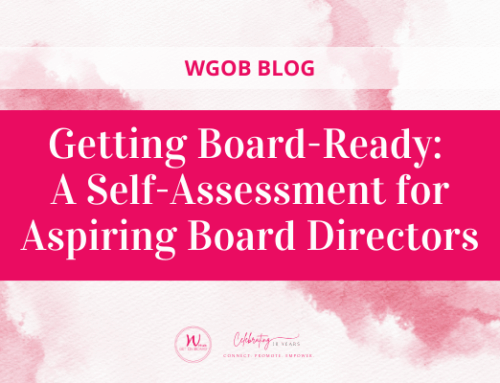Women Get On Board Inc. (WGOB) is a member-based company that connects, promotes and empowers women to corporate boards.
On March 30, WGOB hosted the second part of their virtual WGOB Speaker Series on Stakeholder Incentives & Director Compensation Trends for 2023, sponsored by Southlea Group. This time, the discussion focused on director compensation.
To kick off the event, Deborah Rosati, FCPA, FCA, ICD.D, GCB.D, CCB.D, Corporate Director and WGOB Founder and CEO, introduced the first two speakers:
- Amanda Voegeli, President Managing Partner at Southlea Group
- Ryan Resch, Founder and Senior Partner at Southlea Group
Ryan introduced the topic and then presented the findings from Southlea’s annual review of S&P/TSX60 company director compensation pay levels. As he explained, the findings are helpful for understanding the current state of director pay at major Canadian companies.
The findings
Ryan broke down the findings into some key takeaways.
The first metric he examined was total board member compensation, broken down by company size. The data showed that while there was a broad pay range within each size category, overall, larger organizations offer greater compensation.
“There’s a clear relationship between company size and pay,” said Ryan.
In terms of the type of compensation offered, a few trends were notable. Most board members received retainers in cash and equity, with 97 percent receiving cash and 74 percent receiving equity. Ryan pointed out that the prevalence of meeting fees as compensation has decreased, with just 21 percent of board members receiving per-meeting payments.
As for pay levels, Southlea reported that the 50th percentile of cash compensation in 2021 (the year examined by the report) was $80,000, while equity was $100,000, and meeting fees were $1,500 per meeting. Southlea’s report also showed that, on average, approximately 55 percent of total compensation was provided in the form of equity, typically as a deferred share unit (DSU). Almost all companies had share ownership requirements for board members, which were usually close to three times the cash retainer.
In addition to the analysis of total pay, the report broke down the compensation levels that directors could expect from serving as board chair, committee chair, committee member, committee chair or lead director. The 50th percentile for compensation in each role was as follows:
- Audit committee member: $10,000
- Compensation/HR committee member: $9,000
- Nominating/governance committee member: $7,500
- Board chair: $300,000 or 1.8x board members
- Lead director: $215,000 or $1.2x board members
- Audit committee chair: $25,000
- Compensation/HR committee chair: $20,000
- Nominating/governance committee member: $1,500
Ryan explained that it’s now considered standard practice to pay an added retainer to committee chairs.
“The prevalence of additional compensation for committee chairs is fairly common and virtually universal for an audit committee chair,” said Ryan.
Trends in director compensation in 2023
After the overview of Southlea Group’s findings, Amanda introduced Kim Keating, Professional Engineer and Board Director, for a fireside chat on the future of director compensation.
Kim highlighted a few key trends she has been seeing surrounding the topic. The primary development? ESG.
“ESG has become a topic of not just critical importance, but almost transformational in terms of how we think about risk,” said Kim.
Board structure and compensation have both shifted to reflect that reality, with compensation for committees that handle ESG issues rising to be close to or equal to that of the most important committees, such as the audit committee. Kim also noted that overall, differing compensation rates between committees are less common than they once were.
Amanda drew attention to another shift that’s been happening recently in compensation—the move towards the all-in-one retainer. While it was once standard for boards to compensate members on a per-meeting basis, paying a single retainer that includes a combination of cash and equity is now becoming more conventional.
Kim agreed that it’s a sensible evolution for most companies. She noted that the only exception may be boards requiring a greater-than-average number of meetings.
Next, the conversation turned to the issue of equity. Kim and Amanda weighed the advantages and disadvantages of receiving DSUs as compensation, recognizing that board members do not have access to the income from those shares until after they retire. Amanda said it’s one of the top issues she discusses with directors, especially those who are younger or may prefer more immediate income. For this reason, there seems to be an appetite for flexibility in equity compensation packages to account for personal circumstances.
Kim agreed, noting that flexibility is becoming more common in director compensation in general.
“In my experience, the expectation is that you keep [compensation] simple, flexible and fair,” said Kim.
Kim and Amanda also touched on the evolution of travel pay. Recently, more companies have begun to recognize that if directors travel for board meetings, they should be compensated accordingly. In addition to covering travel costs, companies should pay directors from out of town a reasonable supplementary fee for their time. The extra compensation acknowledges the time spent in transit and helps to level the playing field for those who live in geographic areas outside the major hubs.
Conclusion
As the conversation wrapped up, Kim noted that director compensation is a continually evolving topic, and board leaders should keep a close eye on the changes.
“I know it’s not just about the compensation,” she said. “But it’s an element of the decision when the time comes.”
That’s precisely why it’s critical for women to be informed about trends in director compensation. Understanding what to expect around the negotiating table is vital so you can make the best decision for your board journey.






